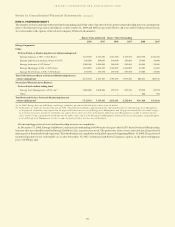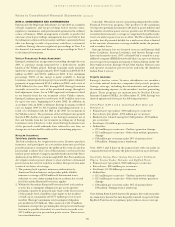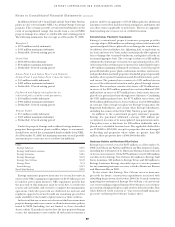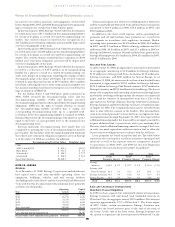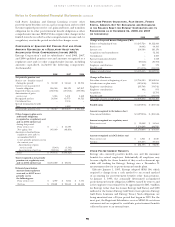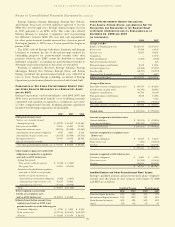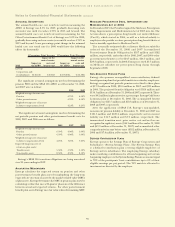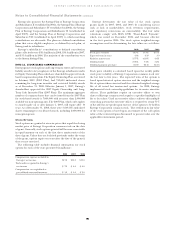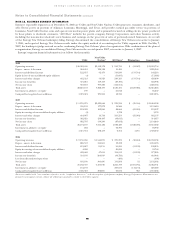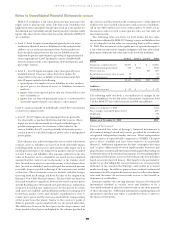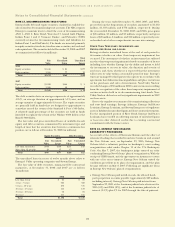Entergy 2008 Annual Report Download - page 96
Download and view the complete annual report
Please find page 96 of the 2008 Entergy annual report below. You can navigate through the pages in the report by either clicking on the pages listed below, or by using the keyword search tool below to find specific information within the annual report.
9494
ENTERGY CORPORATION AND SUBSIDIARIES 2008
Notes to Consolidated Financial Statements continued
94
AC T U A R I A L AS S U M P T I O N S
The assumed health care cost trend rate used in measuring the
APBO of Entergy was 8.5% for 2009, gradually decreasing each
successive year until it reaches 4.75% in 2015 and beyond. The
assumed health care cost trend rate used in measuring the Net
Other Postretirement Benefit Cost of Entergy was 9.0% for 2008,
gradually decreasing each successive year until it reaches 4.75% in
2013 and beyond. A one percentage point change in the assumed
health care cost trend rate for 2008 would have the following
effects (in thousands):
1 Percentage Point Increase 1 Percentage Point Decrease
Impact on the Impact on the
sum of service sum of service
Impact on costs and Impact on costs and
2008 the APBO interest cost the APBO interest cost
Entergy
Corporation and
its subsidiaries $118,645 $16,862 $(105,248) $(14,382)
The significant actuarial assumptions used in determining the
pension PBO and the SFAS 106 APBO as of December 31, 2008,
and 2007 were as follows:
2008 2007
Weighted-average discount rate:
Pension 6.75% 6.50%
Other postretirement 6.70% 6.50%
Weighted-average rate of increase
in future compensation levels 4.23% 4.23%
The significant actuarial assumptions used in determining the
net periodic pension and other postretirement benefit costs for
2008, 2007, and 2006 were as follows:
2008 2007 2006
Weighted-average discount rate:
Pension 6.50% 6.00% 5.90%
Other postretirement 6.50% 6.00% 5.90%
Weighted-average rate of increase
in future compensation levels 4.23% 3.25% 3.25%
Expected long-term rate of
return on plan assets:
Taxable assets 5.50% 5.50% 5.50%
Non-taxable assets 8.50% 8.50% 8.50%
Entergy’s SFAS 106 transition obligations are being amortized
over 20 years ending in 2012.
AC C O U N T I N G ME C H A N I S M S
Entergy calculates the expected return on pension and other
postretirement benefit plan assets by multiplying the long-term
expected rate of return on assets by the market-related value (MRV)
of plan assets. Entergy determines the MRV of pension plan assets by
calculating a value that uses a 20-quarter phase-in of the difference
between actual and expected returns. For other postretirement
benefit plan assets Entergy uses fair value when determining MRV.
ME D I C A R E PR E S C R I P T I O N DR U G , IM P R O V E M E N T A N D
MO D E R N I Z A T I O N AC T O F 2003
In December 2003, the President signed the Medicare Prescription
Drug, Improvement and Modernization Act of 2003 into law. The
Act introduces a prescription drug benefit cost under Medicare
(Part D), which started in 2006, as well as a federal subsidy to
employers who provide a retiree prescription drug benefit that is at
least actuarially equivalent to Medicare Part D.
The actuarially estimated effect of future Medicare subsidies
reduced the December 31, 2008 and 2007 Accumulated
Postretirement Benefit Obligation by $187 million and $182
million, respectively, and reduced the 2008, 2007, and 2006 other
postretirement benefit cost by $24.7 million, $26.5 million, and
$29.3 million, respectively. In 2008, Entergy received $5.7 million
in Medicare subsidies for prescription drug claims through
September 2008.
NO N -QU A L I F I E D PE N S I O N PL A N S
Entergy also sponsors non-qualified, non-contributory defined
benefit pension plans that provide benefits to certain key employees.
Entergy recognized net periodic pension cost related to these plans
of $17.2 million in 2008, $20.6 million in 2007, and $21 million
in 2006. The projected benefit obligation was $138.4 million and
$134.5 million as of December 31, 2008 and 2007, respectively. There
were $0.2 million in plan assets for a pre-merger Entergy Gulf States
Louisiana plan at December 31, 2008. The accumulated benefit
obligation was $125.5 million and $118 million as of December 31,
2008 and 2007, respectively.
After the application of SFAS 158, Entergy’s non-qualified,
non-current pension liability at December 31, 2008 and 2007 was
$121.5 million and $128.4 million, respectively; and its current
liability was $16.7 million and $5.9 million, respectively. The
unamortized transition asset, prior service cost and net loss are
recognized in regulatory assets ($44.1 million at December 31, 2008
and $43.9 million at December 31, 2007) and accumulated other
comprehensive income before taxes ($18.2 million at December 31,
2008 and $17.4 million at December 31, 2007.)
DE F I N E D CO N T R I B U T I O N PL A N S
Entergy sponsors the Savings Plan of Entergy Corporation and
Subsidiaries (System Savings Plan). The System Savings Plan
is a defined contribution plan covering eligible employees of
Entergy and its subsidiaries. The employing Entergy subsidiary
makes matching contributions for all non-bargaining and certain
bargaining employees to the System Savings Plan in an amount equal
to 70% of the participants’ basic contributions, up to 6% of their
eligible earnings per pay period. The 70% match is allocated to
investments as directed by the employee.


